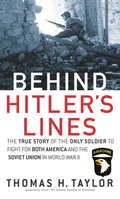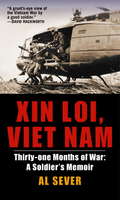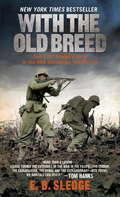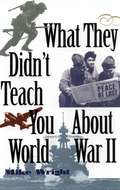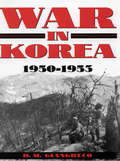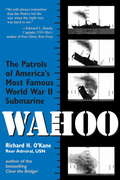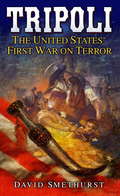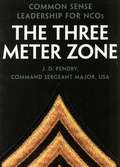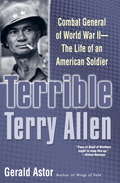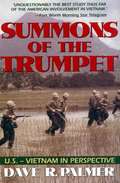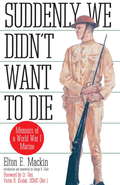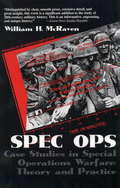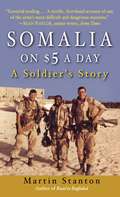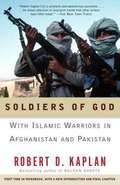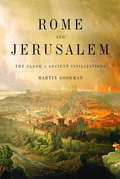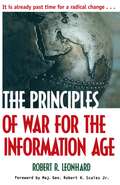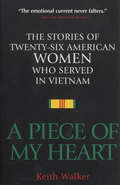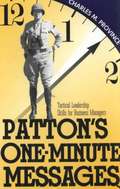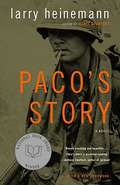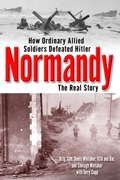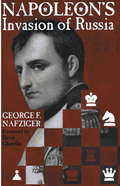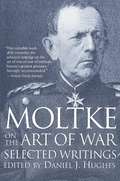- Table View
- List View
Behind Hitler's Lines: The True Story of the Only Soldier to Fight for both America and the Soviet Union in World War II
by Thomas H. TaylorAs the twentieth century closed, the veterans of its defining war passed away at a rate of a thousand per day. Fortunately, D-Day paratrooper Joseph Beyrle met author Thomas H. Taylor in time to record Behind Hitler's Lines, the true story of the first American paratrooper to land in Normandy and the only soldier to fight for both the United States and the Soviet Union against Nazi Germany. It is a story of battle, followed by a succession of captures, escapes, recaptures, and re-escapes, then battle once more, in the final months of fighting on the Eastern Front. For these unique experiences, both President Bill Clinton and President Boris Yeltsin honored Joe Beyrle on the fiftieth anniversary of V-E Day. Beyrle did not strive to be a part of history, but history kept visiting him. Twice before the invasion he parachuted into Normandy, bearing gold for the French resistance. D Day resulted in his capture, and he was mistaken for a German line-crosser - a soldier who had, in fact, died in the attempt. Eventually Joe was held under guard at the American embassy in Moscow, suspected of being a Nazi assassin. Fingerprints saved him, confirming that he'd been wounded five times, and that he bore a safe-conduct pass written by marshal Zhukov after the Wehrmacht wrested Joe, at gunpoint, from execution by the Gestapo. In the ruins of Warsaw his life was saved again, this time by Polish nuns. Some of Joe's story is in his own words - a voice that will be among the last and best we hear firsthand from World War II.
Inside the Vatican of Pius XII: The Memoir of an American Diplomat During World War II
by Harold H. Tittmann IIIAn invaluable contribution to the history of the Catholic Church during the Second World War, this is a richly detailed eyewitness account of the life and politics of the Vatican by an American who worked there from 1940 to 1944. The question of whether Pius XII and the Vatican must bear blame for failing to act decisively in response to Hitler's Final Solution is as hotly debated today as in the years directly following World War II. INSIDE THE VATICAN OF PIUS XII presents for the first time the obse...
Xin Loi, Viet Nam: Thirty-one Months of War: A Soldier's Memoir
by Al SeverAll the hell, horror, and heroism of helicopter gunship combat above the jungles of Vietnam is captured in this gritty, gut-wrenching, firsthand account by a veteran of nearly all the war's major campaigns.
With the Old Breed: At Peleliu and Okinawa
by E. B. SledgeIn The Wall Street Journal, Victor Davis Hanson named With the Old Breed one of the top five books on epic twentieth-century battles. Studs Terkel interviewed the author for his definitive oral history, The Good War. Now E. B. Sledge's acclaimed first-person account of fighting at Peleliu and Okinawa returns to thrill, edify, and inspire a new generation.An Alabama boy steeped in American history and enamored of such heroes as George Washington and Daniel Boone, Eugene B. Sledge became part of the war's famous 1st Marine Division-3d Battalion, 5th Marines. Even after intense training, he was shocked to be thrown into the battle of Peleliu, where "the world was a nightmare of flashes, explosions, and snapping bullets." By the time Sledge hit the hell of Okinawa, he was a combat vet, still filled with fear but no longer with panic.Based on notes Sledge secretly kept in a copy of the New Testament, With the Old Breed captures with utter simplicity and searing honesty the experience of a soldier in the fierce Pacific Theater. Here is what saved, threatened, and changed his life. Here, too, is the story of how he learned to hate and kill-and came to love-his fellow man.From the Trade Paperback edition.
The Winter War: A Novel
by William DurbinWhen the Soviet Union invades its tiny neighbor Finland in November 1939, Marko volunteers to help the war effort. Even though his leg was weakened by polio, he can ski well, and he becomes a messenger on the front line, skiing in white camouflage through the forests at night. The dark forest is terrifying, and so are the odds against the Finns: the Russians have 4 times as many soldiers and 30 times as many planes. They have 3000 tanks, while the Finns have 30. But a tank is no help in the snowy forest-a boy on skis is. And the Russians don't know winter the way the Finns do, or what tough guerrilla warriors the Finns are. Marko teams up with another messenger, Karl. Gradually Marko learns that Karl's whole family was killed by the Russians. And Karl has a secret-he's really Kaari, a girl who joined up to get revenge for her family's deaths.From the Hardcover edition.
What They Didn't Teach You About World War II (What They Didnt Teach You)
by Mike WrightProvides a different view of World War II.
War In Korea, 1950-1953: A Pictorial History
by D. M. GiangrecoA pictoral tribute to US forces in the Asian peninsula, compiled by military historian Giangreco. The 521 black- and-white photographs encompass the Army and Marine ground forces, operations carried out by the US Navy and Air Force, and troops of other countries operating under the flag of the United Nations. The text is limited to captions; there is neither index or bibliography. Annotation c. Book News, Inc., Portland, OR (booknews.com)
Wahoo
by Richard O'KaneThe USS Wahoo's performance in sinking Japanese ships in the farthest reaches of the empire is legendary.From the Trade Paperback edition.
Tripoli: The United States' First War on Terror
by David SmethurstTHE TRUE STORY OF WILLIAM EATON AND THE UNITED STATES' FIRST ATTEMPT AT REGIME CHANGE. April 27, 1805. The impasse in the four-year war between the Barbary pirate state of Tripoli and the United States is about to be broken. William Eaton has led his ragtag army of Greeks, Arabs, and U.S. Marines across five hundred grueling miles of sun-scorched desert from Alexandria, Egypt, to Tripoli's heavily defended port fortress of Derna. Outnumbered ten to one, the exhausted, thirsty men carry out Eaton's daring charge on the pirate fortress-and enter the history books and anthem of the U.S. Marines.David Smethurst vividly chronicles America's Barbary War and the pivotal role of William Eaton-firebrand, soldier, and statesman. From the former army captain's appointment as consul to the Barbary Coast in 1799 to the enemy's capture of the USS Pennsylvania and her three hundred sailors to Eaton's valiant attack and its stunning aftermath, Tripoli is a fascinating tale of polished diplomacy, raw heroism, and a man as fearless and independent as the young nation he represented.
The Three Meter Zone: Common Sense Leadership for NCOs
by J. D. PendryA pocket-sized guide to being a good leader, for non-commissioned officers (NCOs). Discusses US Army values in 'user-friendly' terms, from the perspective of a former member of the NCO core. Introduces three different types of leadership styles for 3-meter, 50-meter, and 100-meter soldiers.
Terrible Terry Allen (Combat General of World War II--The Life of an American Soldier)
by Gerald AstorTerry de la Mesa Allen’s mother was the daughter of a Spanish officer, and his father was a career U. S. Army officer. Despite this impressive martial heritage, success in the military seemed unlikely for Allen as he failed out of West Point—twice—ultimately gaining his commission through Catholic University’s R. O. T. C. program. In World War I, the young officer commanded an infantry battalion and distinguished himself as a fearless combat leader, personally leading patrols into no-man’s-land. In 1940, with another world war looming, newly appointed army chief of staff Gen. George C. Marshall reached down through the ranks and, ahead of almost a thousand more senior colonels, promoted Patton, Eisenhower, Allen, and other younger officers to brigadier general. For Operation Torch, the invasion of North Africa, Allen, now a two-star general, commanded the Big Red One, the First Infantry Division, spearheading the American attack against the Nazis. Despite a stellar combat record, however, Major General Allen found himself in hot water with the big brass. Allen and his troops had become notorious for their lack of discipline off the battlefield. When Seventh Army commander George Patton was pressed by his deputy Omar Bradley to replace “Terrible Terry” before the invasion of Sicily, he demurred, favoring Allen’s success in combat. At the end of the Sicily campaign, with Allen’s protector Patton out of the way (relieved for slapping a soldier), Omar Bradley fired Allen and sent him packing back to the States, seemingly in terminal disgrace. Once again, however, George Marshall reached down and in October 1944, Terrible Terry was given command of another infantry division, the 104th Timberwolves and took it into heavy combat in Belgium. Hard fighting continued as Allen’s division spearheaded the U. S. First Army’s advance across Germany. On 26 April 1945, Terrible Terry Allen’s hard-charging Timberwolves became the first American outfit to link up with the Soviet Union’s Red Army. Terrible Terry Allen was one of the most remarkable American soldiers of World War II or any war. Hard bitten, profane, and combative, Allen disdained the “book,” but he knew how to wage war. He was a master of strategy, tactics, weaponry, and, most importantly, soldiers in combat.
Summons of Trumpet: U.S.-Vietnam in Perspective
by Dave R. PalmerSoldier/scholar Palmer traces the history of the American involvement in Vietnam and shows how events in both the U.S. and Vietnam became inextricably linked as domestic dissent and a lack of realistic, viable military strategy ultimately led to America's first lost war.
Suddenly We Didn't Want To Die: Memoirs of a World War I Marine
by Elton E. MackinMackin's memoirs are a haunting portrayal of war in the tradition of All Quiet on the Western Front.
Spec Ops
by William H. McravenVice Adm. William H. McRaven helped to devise the strategy for how to bring down Osama bin Laden, and commanded the courageous U.S. military unit that carried it out on May 1, 2011, ending one of the greatest manhunts in history. In Spec Ops, a well-organized and deeply researched study, McRaven analyzes eight classic special operations. Six are from WWII: the German commando raid on the Belgian fort Eben Emael (1940); the Italian torpedo attack on the Alexandria harbor (1941); the British commando raid on Nazaire, France (1942); the German glider rescue of Benito Mussolini (1943); the British midget-submarine attack on the Tirpitz (1943); and the U.S. Ranger rescue mission at the Cabanatuan POW camp in the Philippines (1945). The two post-WWII examples are the U.S. Army raid on the Son Tay POW camp in North Vietnam (1970) and the Israeli rescue of the skyjacked hostages in Entebbe, Uganda (1976). McRaven--who commands a U.S. Navy SEAL team--pinpoints six essential principles of "spec ops" success: simplicity, security, repetition, surprise, speed and purpose. For each of the case studies, he provides political and military context, a meticulous reconstruction of the mission itself and an analysis of the operation in relation to his six principles. McRaven deems the Son Tay raid "the best modern example of a successful spec op [which] should be considered textbook material for future missions." His own book is an instructive textbook that will be closely studied by students of the military arts. Maps, photos.
Somalia on $5 a Day: A Soldier's Story
by Martin Stanton"Stanton's battalion was the first army unit in Somalia in 1992 and it did one hell of a job accomplishing a difficult mission where there wasn't a template. I had the pleasure of tagging along with his unit and saw first-hand how its leaders dealt with and solved problems. . . . A first-rate book and a must read. All professional soldier-leaders should carry Stanton's book in their rucksacks."--DAVID H. HACKWORTH Author of About Face and Hazardous DutyA country torn by seemingly endless war, a people tormented and victimized by relentless banditry---into this land of warlords came the soldiers of the army's elite 10th Mountain Division. They were strangers in a strange land sent to restore hope to this cauldron of misery and despair. The Pentagon deemed it a hostile fire zone thereby earning each soldier a monthly bonus of $150-- Somalia on $5.00 a day. Major Stanton and the infantrymen of Task Force 2-87 found themselves in unfamiliar surroundings, trying to accomplish a vague and constantly changing mission where knowing the good guys from the bad guys was nearly impossible. When the focus of Restore Hope changed from limited famine relief to nation building, the men found themselves in armed clashes with Somali warlords. In this exciting and often humorous memoir, Stanton relates the mounting frustrations experienced by the U.S. soldiers, futility that culminated in the infamous chaos on the streets of Mogadishu.From the Paperback edition.
Soldiers of God: With Islamic Warriors in Afghanistan and Pakistan
by Robert D. KaplanFirst time in paperback, with a new Introduction and final chapter. World affairs expert and intrepid travel journalist Robert D. Kaplan braved the dangers of war-ravaged Afghanistan in the 1980s, living among the mujahidin--the "soldiers of god"--whose unwavering devotion to Islam fueled their mission to oust the formidable Soviet invaders. In Soldiers of God we follow Kaplan's extraordinary journey and learn how the thwarted Soviet invasion gave rise to the ruthless Taliban and the defining international conflagration of the twenty-first century. Kaplan returns a decade later and brings to life a lawless frontier. What he reveals is astonishing: teeming refugee camps on the deeply contentious Pakistan-Afghanistan border; a war front that combines primitive fighters with the most technologically advanced weapons known to man; rigorous Islamic indoctrination academies; a land of minefields plagued by drought, fierce tribalism, insurmountable ethnic and religious divisions, an abysmal literacy rate, and legions of war orphans who seek stability in military brotherhood. Traveling alongside Islamic guerrilla fighters, sharing their food, observing their piety in the face of deprivation, and witnessing their determination, Kaplan offers a unique opportunity to increase our understanding of a people and a country that are at the center of world events.
Rome and Jerusalem: The Clash of Ancient Civilizations
by Martin GoodmanA magisterial history of the titanic struggle between the Roman and Jewish worlds that led to the destruction of Jerusalem.Martin Goodman—equally renowned in Jewish and in Roman studies—examines this conflict, its causes, and its consequences with unprecedented authority and thoroughness. He delineates the incompatibility between the cultural, political, and religious beliefs and practices of the two peoples and explains how Rome's interests were served by a policy of brutality against the Jews. At the same time, Christians began to distance themselves from their origins, becoming increasingly hostile toward Jews as Christian influence spread within the empire. This is the authoritative work of how these two great civilizations collided and how the reverberations are felt to this day.From the Trade Paperback edition.
The Principles of War for the Information Age
by Robert LeonhardOne of the most cogent and respected strategic theorists in today's military sounds the alarm: We have no viable doctrine for tomorrow's war. The advent of the information age renders the hallowed Principles of War useless. Forged in agrarian times and honed by the more modern conflicts of the industrial age, the principles that have guided generations of America's military leaders have become dangerously outmoded. In this, his latest book, Lt. Col. Robert R. Leonhard, author of the influential Art of Maneuver and Fighting by Minutes, proposes a new set of principles, indeed a new approach to armed conflict.
A Piece of My Heart: The Stories of 26 American Women Who Served in Vietnam
by Keith WalkerA decade after America pulled out of Vietnam, the seeds of the often heart- wrenching oral history, A Piece of My Heart, were sown when writer and filmmaker Keith Walker met a woman who had been an emergency room nurse in Cu Chi and Da Nang. She and 25 others recount the time they spent "in country" as part of 15,000 American women who volunteered or served as nurses and in the military.NOTE: This edition does not include photographs.
Patton's One-Minute Messages: Tactical Leadership Skills of Business Managers
by Charles ProvinceThis collection of George S. Patton's pithy one-liners shows how business managers can succeed by applying the combat-tested principles of one of America's most famous battlefield leaders. Also featured are the works of W. Edwards Deming and Walter A. Shewhart, two pioneers in quality control who have influenced management practice for over 50 years.
Paco's Story
by Larry HeinemannPaco Sullivan is the only man in Alpha Company to survive a cataclysmic Viet Cong attack on Fire Base Harriette in Vietnam. Everyone else is annihilated. When a medic finally rescues Paco almost two days later, he is waiting to die, flies and maggots covering his burnt, shattered body. He winds up back in the US with his legs full of pins, daily rations of Librium and Valium, and no sense of what to do next. One evening, on the tail of a rainstorm, he limps off the bus and into the small town of Boone, determined to find a real job and a real bed-but no matter how hard he works, nothing muffles the anguish in his mind and body. Brilliantly and vividly written,Paco's Story plunges you into the violence and casual cruelty of the Vietnam War, and the ghostly aftermath that often dealt the harshest blows. <P><P> Winner of the National Book Award
Other Echoes
by Adele GerasEighteen-year-old Flora is recovering from "nervous exhaustion" in the sanatorium at her boarding school. She is supposed to rest. But the rest brings back her childhood memories of living in Borneo, where she encountered people and events shaped by the tragedies of the Second World War, when the island was occupied by Japanese soldiers and their concentration camps. Award-winning author Adèle Geras weaves the captivating story of a young woman who, by coming to terms with her memories of the past, is able to move on to a new phase of her life.From the Hardcover edition.
Normandy
by Shelagh Whitaker Dennis Whitaker"It was the [allied armies'] valor, their endurance, and their ability to adapt that won the battle of Normandy and launched the liberation of Western Europe." --from Normandy: The Real StoryFor decades, it's been the conventional wisdom that "brute force" alone beat the German army at Normandy. Now a definitive new history, coauthored by a highly decorated field commander, proves otherwise. Using archival data, oral histories, and exclusive new interviews, Normandy: The Real Story takes the reader deep into the minds, hearts, and souls of the allied armies to show how--despite the shortcomings of their superiors and the inferiority of their weaponry--they destroyed two well-equipped German armies and won the war.Here is the crucial summer of 1944 as seen by both sides, from the British spy, code-named "Garbo," who successfully misled the Nazis about the time and place of the D-day landings, to the poor planning for action after the assault that forced the allies to fight for nine weeks "field to field, hedgerow to hedgerow." Here too are the questionable command decisions of Montgomery, Eisenhower, and Bradley, the insatiable ego of Patton. Yet, fighting in some of the most miserable conditions of the war, the allied soldiers used ingenuity, resilience, and raw courage to drive the enemy from France in what John Keegan describes as "the biggest disaster to hit the German army in the course of the war." Normandy is an inspiring tribute to the common fighting men of five nations who won the pivotal campaign that lead to peace and freedom.From the Trade Paperback edition.
Napoleon's Invasion of Russia
by George NafzigerWidely-regarded as one of America's greatest historians, Dodge's work on Napoleon's invasion of Russia in 1812 is without parallel for scholarship or psychological sophistication. Beginning with Napoleon's doomed march on Russia, Dodge traces Napoleon's state of mind and the factors behind his decisions using personal letters and genuine reports. How could Napoleon, such a proficient strategist, have led his army into such an atrocious situation and underestimated the severity of the Russian winter? In one of the most imposing invasions ever attempted - Napoleon could draw upon 600,000 men and 250,000 horses - the Grande Armee's success seemed inevitable. Few could imagine that only 100,000 would reach Moscow and all without having achieved the decisive battle that Napoleon sought - one of the greatest disasters of military history was in the making. Dodge sheds new light on Napoleon's character as a soldier by focusing on his personal matters and behavior, putting aside his political concerns. The narrative provides the perfect introduction for those who want to learn more about Napoleon and the disastrous winter of 1812, as well as for the more seasoned Napoleonic scholar.
Moltke on the Art of War: Selected Writings
by Daniel HughesPrussian hero Field Marshal Helmuth Graf von Moltke was the architect of the German way of war.
